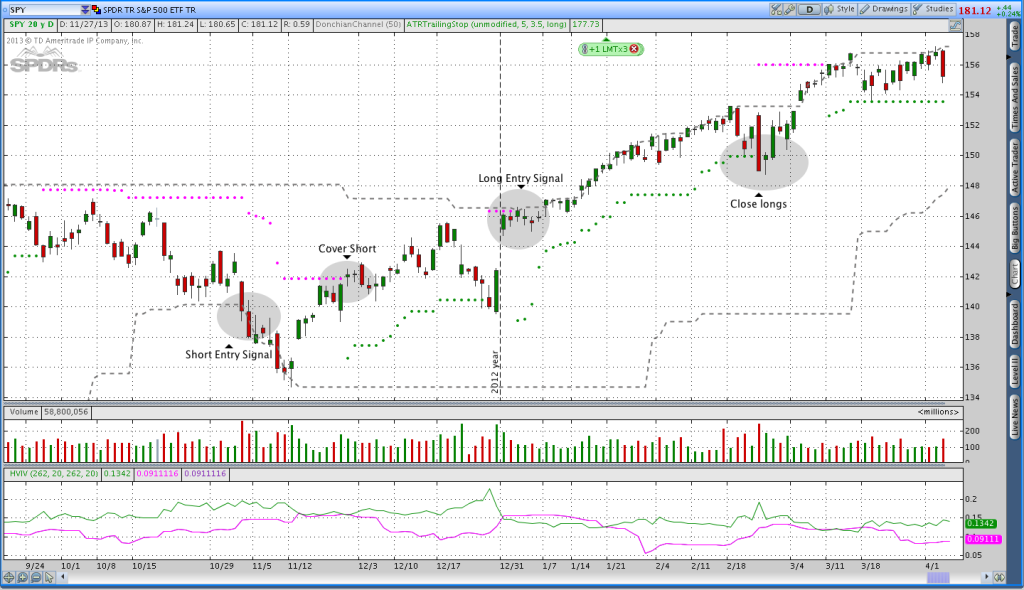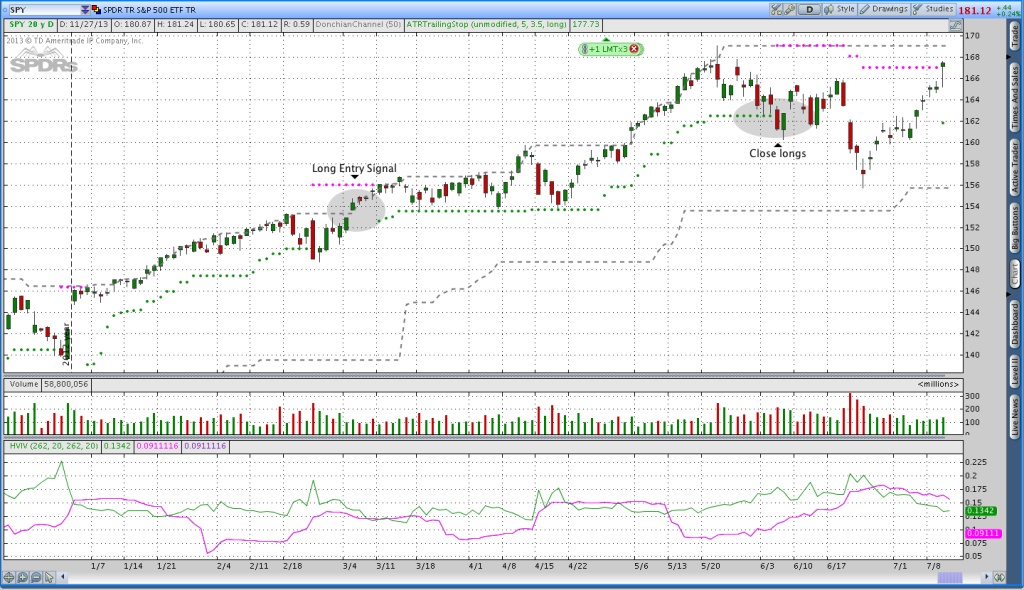Theta Breakout: Selling Options on a Donchian Channel Breakout
The General Idea:
 Better, faster, stronger? My initial thoughts about combining Trend Following and Options trading came about a few years ago after the 2008 crash. At the time, I was trading Iron Condors on SPY and IWM and trying to figure out why it was so hard. Apparently, when you trade a delta neutral strategy in a strongly trending market, it can be challenging. However, I was also trading a Donchian Channel Breakout system and watching stocks make a seemingly endless march up the channel.
Better, faster, stronger? My initial thoughts about combining Trend Following and Options trading came about a few years ago after the 2008 crash. At the time, I was trading Iron Condors on SPY and IWM and trying to figure out why it was so hard. Apparently, when you trade a delta neutral strategy in a strongly trending market, it can be challenging. However, I was also trading a Donchian Channel Breakout system and watching stocks make a seemingly endless march up the channel.
The strong trend in stocks during 2009 (this year isn’t anything to scoff at either) made me think that trading a trend following options system would make more sense than trading Iron Condors. Over time what I’ve come to realize is that the market environment is what really matters and this system uses objective rules to define and trade the market environment.
Many options traders attempt to trade the same strategy every month, but certain strategies work better in different months than others. The reason that certain strategies work better in some months than others is due to some combination of market and volatility conditions. The Theta Breakout system is a way to objectively step back and be aware of what the market is doing rather than hoping some particular strategy works well.
Basic Entry Rules:
Initiate new options positions when a new 50 day Donchian channel breakout is triggered. The options trades are always positive theta and in the direction of the trend. If a new 50 day high is hit, the system will sell naked puts or put verticals while new 50 day lows will trigger the system to sell naked calls or call verticals.

Basic Exit Rules:
Always exit positions if the maximum risk is hit. Because this system has a higher than 50% probability of success, the maximum risk is also equal to the maximum credit received. For example, if a 50 day high is made and the system sells a Put for .50 with a profit target of .45, the maximum risk should not exceed .40-.45. In other words, I’m not willing to take a loss that will take me more than one trade to recover.
In addition to the risk exit rule, a trailing stop is also in place to liquidate winning positions with a profit. This system uses the same Average True Range trailing stop described in the Theta Trend System. Full parameters for the Average True Range Trailing stop can be found in the System Document (available as a free download), but the general setting is 3.5 times the 5 day Average True Range.
Trading Across Multiple Expiration Cycles:
When trades last longer than 30 days and price has moved in the direction of the breakout, the premium remaining on the short options is fairly minimal. As a result, the system will look to resell the next expiration cycle when those options move into the preferred time to sell (60-100 days). For example, if the system sells May options with 70 days to expiration and the trend direction is still long when June options have 65-70 days to expiration, the system will close May and sell June.
3 Trading System States:
The Theta Breakout system has three system states: long, short, and flat. The Donchian channel breakout acts as a trend filter more than anything and the trailing stop is an objective way to manage risk. Using a Donchian Breakout to filter the trend means that there will be months where the system has no position because the market is chopping around and between trends. Those periods of chop could be good times to sell Iron Condors, but I’ll leave that for another post.
What Options:
This system sells out of the money naked options with a 10-20 Delta and 60-100 days to expiration. Depending on your risk tolerance, the system could be modified to trade vertical spreads instead of naked options. Sidenote: I’m currently in the process of a manual backtest to determine the best delta to sell and I’ll post the results within the next week or so.
Sample trade:
The image below shows the a sample trade in the S&P 500 (SPY). On March 5, 2013 a Donchian breakout to the upside put the system in a long state and the system remained in a long state until June 5, 2013. On March 5, the system would have sold the May 138 Puts with around 73 days to expiration for a .60 credit. Roughly a month later, on April 17, 2013, the short option could be bought back for .24 and the June options with 65 days to expiration could be sold. Alternatively, the May options could be held further and would have expired worthless.
What Are We Really Doing?
What we’re really doing with the Theta Breakout system is taking the good parts of the Theta Trend system including well defined entry and exit points, consistency across multiple asset classes, and rules for risk management. We’re building on the system by adding Donchian Breakouts as a trend filter for options selling. The original Theta Trend system just used an Average True Range trailing stop and was fairly agnostic about timing while this system times the market in an effort to reduce false signals.
I’ll be talking about the Theta Breakout system more often going forward and improving on it. There is a lot more ground to cover with the system including how to enter positions and what markets to trade. Additionally, I’m currently in the process of doing some backtesting to determine the optimal short option delta and will have the results out soon. In the meantime, have a great Thanksgiving and please share this post if you enjoyed it.
Questions about what I’m doing here? Send me an email through the contact form.

Great ideas here! According to your experience is this system more powerful (profitable) that the original Theta Trend system? Have you made some back tests on this idea?
Thanks LT! I’m currently in the process of doing a backtest on the system and my initial results suggest that the system has a higher winning percentage than the original system. From what I’ve seen so far, it looks like the Donchian channel acts as a filter that reduces the number of trades in choppy periods and that helps the bottom line.
I should have some backtest results out this weekend on the blog. In the meantime, you might want to check out this post about improving the original system:
http://www.thetatrend.com/a-simple-tweak-that-more-than-doubles-the-profitability-of-a-credit-spread-system/
Here’s a sneak peak at the initial results, enjoy:
http://www.thetatrend.com/gamma-insights-initial-theta-breakout-backtest-results/
Great strategy Dan! I have actually been trading a similar strategy for this past year and results are good. The thing is that trading IRON CONDORS each month can be an error because markets are trending and not going sideways. So having a trend following system in your arsenal is very powerful. One major difference in the way I do mine is that I buy a LEAP and sell a short term call against it. It like a covered call or a diagonal spread and 2013 rocked!!!!
Thanks! Yeah, there are a lot of ways to play the game and I can see how your strategy would have worked well in equities this year. Thanks for sharing with everyone; it’s always great to hear how other people think about the market.
Love the daft punk reference!